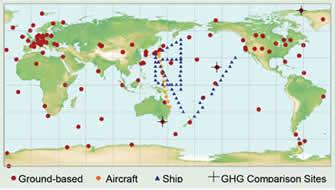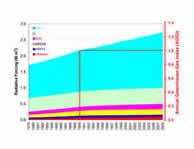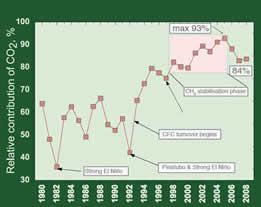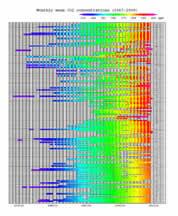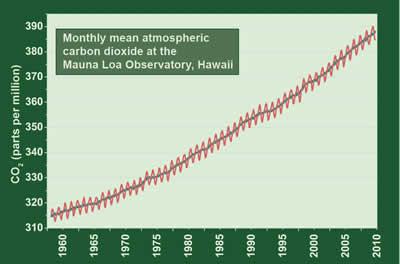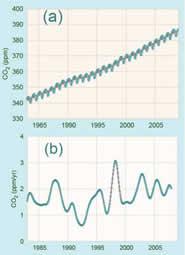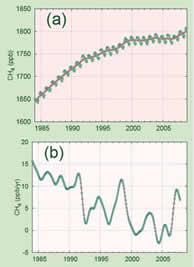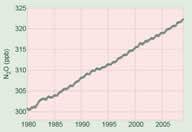WMO Greenhouse Gas Bulletin
The State of Greenhouse Gases in the Atmosphere Using Global Observations through 2008
Executive summary
The latest analysis of observations from WMO's Global Atmosphere Watch (GAW) Programme shows that the globally averaged mixing ratios of carbon dioxide (CO2), methane (CH4) and nitrous oxide (N2O) have reached new highs in 2008 with CO2 at 385.2 ppm, CH4 at 1797 ppb and N2O at 321.8 ppb: higher than those in pre-industrial times (before 1750) by 38%, 157% and 19%, respectively. Atmospheric growth rates of CO2 and N2O in 2008 are consistent with recent years. The increase in atmospheric CH4 was 7 ppb from 2007 to 2008, similar to the increase of the year before. These are the largest increases since 1998. The NOAA Annual Greenhouse Gas Index (AGGI) shows that from 1990 to 2008 the radiative forcing by all long-lived greenhouse gases has increased by 26.2%. The combined radiative forcing by halocarbons is nearly double that of N2O. Some halocarbons are decreasing slowly as a result of emission reductions under the Montreal Protocol on Substances That Deplete the Ozone Layer, whereas others are increasing rapidly. |
Overview
This is the fifth in a series of WMO-GAW Annual Greenhouse Gas Bulletins. Each year, they report the global consensus on the latest changes and atmospheric burdens of the most important, long-lived greenhouse gases: carbon dioxide (CO2), methane (CH4), nitrous oxide (N2O), CFC-12 and CFC-11, as well as a summary of the contributions of the lesser gases.
Water vapour is the most important greenhouse gas, but it is connected to human activities only through climate feedbacks. This Bulletin focuses on those greenhouse gases that are directly influenced by humans and that are generally much longer lived in the atmosphere than water vapour. The three primary greenhouse gases are not only closely linked to anthropogenic activities, but also have strong interactions with the biosphere and the oceans. Chemical reactions in the atmosphere affect their abundances as well. Prediction of the evolution of greenhouse gases in the atmosphere requires an understanding of their many sources and sinks.
The Global Atmosphere Watch (GAW) Programme of the World Meteorological Organization (WMO) coordinates systematic observations and analysis of atmospheric composition, including greenhouse gases, and other trace species. The GAW CO2 and CH4 networks are comprehensive networks of the Global Climate Observing System (GCOS). Sites where carbon dioxide is monitored are shown in Figure 1. The network for methane is similar to that. |
Figure 1. The WMO-GAW global network for carbon dioxide. |
|
The measurement data are reported by participating countries and archived and distributed by the World Data Centre for Greenhouse Gases (WDCGG) at the Japan Meteorological Agency (JMA). Statistics on the present global atmospheric abundances and changes of the three major greenhouse gases are given in Table 1. These results are obtained from a global analysis method ( GAW report no. 184) using a data set which is traceable to the WMO World Reference Standard. Data from mobile stations, with the exception of NOAA flask sampling, are not used for global analysis. The three greenhouse gases in Table 1 have been increasing in the atmosphere since the beginning of the industrial age.
Table 2 gives a statistics on the number of stations used for global analysis by WDCGG. |
Table 2.
Number of the data recoreds used in the calculation of globally averaged numbers in this Bulletin (for 2008).
CO2 |
CH4 |
N2O |
CFC11 |
CFC12 |
CFC113 |
CCl4 |
CH3CCl3 |
HCFC141b |
HCFC142b |
HCFC22 |
HFC134a |
HFC152A |
SF6 |
172 |
147 |
58 |
56 |
45 |
31 |
36 |
33 |
8 |
13 |
13 |
8 |
7 |
24 |
Radiative forcing
According to the NOAA Annual Greenhouse Gas Index (AGGI), the total radiative forcing by all long-lived greenhouse gases has increased by 26.2% since 1990 and by 1.3% from 2007 to 2008 (see Figure 2). Five major gases (carbon dioxide (CO2), methane (CH4), nitrous oxide (N2O), CFC-12 and CFC-11) contribute about 96% of the increase in radiative forcing due to long-lived greenhouse gases that has occurred since 1750.
(*) This sign shows, that the percentage is calculated as the relative contribution of the mentioned
gas to the increase in global radiative forcing caused by all longlived
greenhouse gases since 1750. |
Figure 2. Atmospheric radiative forcing by long-lived greenhouse gases (after 1750) and the 2008 update of the NOAA Annual Greenhouse Gas Index (AGGI). 1990 has been chosen as the year of reference (AGGI = 1) for the Index. |
Are there any signs of the growing importance of CO2?
Relative contribution of major greenhouse gases to the overall change in radiative forcing between 1979 and 1984 (a) and from 2003 to 2008 (b). |
The importance of CO2 has increased substantially. Whereas the contribution from CFCs and halons has turned around and now is negative, the contributions from HCFCs and HFCs are increasing rapidly. From 2003 to 2008 they were, together with SF6, responsible for 8.9 % of the increase in the radiative forcing caused by long-lived greenhouse gases. |
The relative contribution of CO2 to the annual increase in the greenhouse effect (radiative forcing) from 1980 to 2008. With the phase-out of CFCs, starting in the early 1990s, due to the Montrea Protocol, CO2 gained importance rapidly. The levelling off of methane from the late 1990s led to an additional increase in the contribution from CO2, reaching a maximum of 93% (*) in 2005. The recent increase in methane has caused the CO2 contribution to drop to 84% (*) in 2008. Nevertheless, the contribution of CO2 is still more than four times larger than the combined effect of all the other longlived greenhouse gases. |
|
Carbon Dioxide (CO2)
CO2 is the single most important human-emitted greenhouse gas in the atmosphere, contributing 63.5 % (*) to the overall global radiative forcing. However, it is responsible for 85% of the increase in radiative forcing over the past decade and 86% over the last five years. For about 10,000 years before the industrial revolution, the atmospheric abundance of CO2 was nearly constant at ~ 280ppm (ppm = number of molecules of the gas per million molecules of dry air). This abundance represented a balance between the atmosphere, the oceans and the biosphere.
Monthly means of CO2 mixing ratios are shown on the plot (Figure 3, click to enlarge). The graph shows a substantial increase of the mixing ratio at all reporting stations.
|
Figure 3. Monthly mean CO2 records at individual stations. |
CO2 measured on Mauna Loa constitutes the longest record of direct measurements in the atmosphere. The dark curve behind the monthly means represents the seasonally adjusted data. The amount of CO2 in the atmosphere is increasing exponentially at a rate of about 0.5% per year.
Data courtesy of Scripps Institution of Oceanography, University of California, San Diego and National Oceanic and Atmospheric Administration (NOAA). |
|
Since 1750, atmospheric CO2 has increased by 38%, primarily because of emissions from combustion of fossil fuels (8.62 Gt carbon in 2007) and deforestation and land use change (0.5-2.5 Gt carbon per year over the 2000-2005 time period). High-precision measurements of atmospheric CO2 beginning in 1958 show that the average increase of CO2 in the atmosphere corresponds to ~ 55% of the CO2 emitted by fossil fuel combustion. The remaining fossil fuel-CO2 has been removed from the atmosphere by the oceans and the terrestrial biosphere. Globally averaged CO2 in 2008 was 385.2 ppm and the increase from the year before was 2.0 ppm (Figure 4, click to enlarge). This growth rate is larger than the average for the 1990s (~1.5 ppm/yr), mainly because of increasing emissions of CO2 from fossil fuel combustion. |
Figure 4. Globally averaged CO2 (a) and
its growth rate (b) from 1983 to 2008.
|
What is a contribution of the fossil fuel combustion into the global emissions of the greenhouse gases?
EDGAR4.0 data shows that CO2 emissions from fossil fuel combustion constitute more than a half of all emissions of main greenhouse gases (European Commission, Joint Research Centre (JRC)/Netherlands Environmental Assessment Agency (PBL). Emission Database for Global Atmospheric Research (EDGAR), release version 4.0. http://edgar.jrc.ec.europa.eu, 2009.)
|
What is a spatial distribution of the greenhouse gas emissions?
Global greenhouse gas emissions (CO2, CH4, N2O, SF6, PFCs and HFCs) in the year 2005 Gg CO2-equivalents per 0.1 degree grid cell. Shown are emissions from anthropogenic origin excluding aviation and land-use, land use change and forestry (LULUCF). |
|
Is there any connection between natural factors and CO2 growth rate?
“The terrestrial component of the carbon cycle is responding to climate variations and trends on a global scale. This is exemplified by the strong interannual variations in the globally averaged growth rate of atmospheric CO2, which is tightly correlated with El Niño–Southern Oscillation climate variations.” [M. Heimann & M. Reichstein, Nature, 2008].
The plot shows the monthly datasets of MEI (multivariate El Niño–Southern Oscillation index) and average CO2 mixing ratio (from the South Pole and the Mauna Loa) filtered in a way to removing frequencies corresponding to periods shorter than 1 year and longer than 5 years (the CO2 data courtesy of the Scripps Institution of Oceanography, San Diego, USA, and the MEI index courtesy of the U.S. NOAA Earth System Research Laboratory). There is a very high correlation of ~0.7 between filtered datasets, where the MEI precedes the CO2 growthrate by 3 months. |
Methane (CH4)
Methane contributes 18.2 % (*) to the overall global radiative forcing. Methane is emitted to the atmosphere by natural (~ 40%, e.g., wetlands and termites) and anthropogenic sources (~ 60%, e.g., ruminants, rice agriculture, fossil fuel exploitation, landfills and biomass burning). It is removed from the atmosphere primarily by reaction with the hydroxyl radical (OH). Before the industrial era, atmospheric methane was at ~ 700 ppb (ppb = number of molecules of the gas per billion molecules of dry air).
Monthly means of CH4 mixing ratios are shown on the plot (Figure 5, click to enlarge).
|
Figure 5. Monthly mean CH4 records at individual stations.
|
Increasing emissions from anthropogenic sources are responsible for the 157% increase in CH4. Globally averaged CH4 in 2008 was 1797 ppb, which means an increase of 7 ppb from the year before. It exceeds the highest annual mean abundance recorded so far, which was in 2007 (Figure 6). Methane was increasing by up to 13 ppb per year during the late 1980s, while the growth rate decreased during the past decade. The 7 ppb rise from 2007 to 2008 follows the 7 ppb rise the previous year and they represent the highest annual increases since 1998. From the existing data it is not clear if this 14 ppb increase over two years represents the beginning of a new upward trend in CH4. In order to improve our understanding of the processes that affect CH4 emissions more in situ measurements would be needed close to the source regions.
|
Figure 6. Globally averaged CH4 (a) and its growth rate (b) from 1983 to 2008.
|
Figure 7. Monthly mean N2O records at individual stations. |
Nitrous Oxide (N2O)
Nitrous oxide (N2O) contributes 6.2% (*) to the overall global radiative forcing. Its atmospheric abundance prior to industrialization was 270 ppb. N2O is emitted into the atmosphere from natural and anthropogenic sources, including the oceans, soil, biomass burning, fertilizer use, and various industrial processes. Anthropogenic sources may account for about 40% of total N2O emissions. It is removed from the atmosphere by photochemical processes in the stratosphere. Globally averaged N2O during 2008 was 321.8 ppb, up 0.9 ppb from the year before (Figure 8) and 19% above the preindustrial level. The mean growth rate has been 0.78 ppb per year over the past 10 years. |
Figure 8. Globally averaged monthly
mean mixing ratios of N2O from 1980
to 2008.
|
Other Greenhouse Gases
Sulphur hexafluoride (SF6) is a potent long-lived greenhouse gas controlled by the Kyoto Protocol. It is produced artificially and used as an electrical insulator in power distribution equipment. Its mixing ratio has increased to double that in the mid-1990s (Figure 9). |
Figure 9. Globally averaged monthly mean mixing ratios of SF6. |
The ozone depleting chlorofluorocarbons (CFCs), together with minor halogenated gases contribute 12% (*) to the overall global radiative forcing. While CFCs and most halons are decreasing, hydrochlorofluorocarbons (HCFCs) and hydrofluorocarbons (HFCs), which are also potent greenhouse gases, are increasing at rapid rates, although still low in abundance (Figure 10). |
Figure10. Globally averaged monthly mean mixing ratios of different halocarbons. |
Ozone in the troposphere does not have a long lifetime. However, the greenhouse effect of the tropospheric ozone increase over the last century due to human activities is comparable to that of the halocarbons, although less certain. It is difficult to estimate the global distribution and trend of tropospheric ozone due to its very uneven geographic distribution and high temporal variability.
Many other pollutants (e.g. carbon monoxide, nitrogen oxides and volatile organic compounds), although they are insignificant as greenhouse gases, have an indirect effect on the radiative forcing through their impact on tropospheric ozone, CO2 and methane. Aerosols (suspended particulate matter) including black carbon are also short-lived substances that influence radiative forcing.
All the gases mentioned here and aerosols are monitored by the WMO-GAW Programme, supported by member countries, and contributing networks.
|

